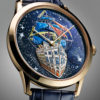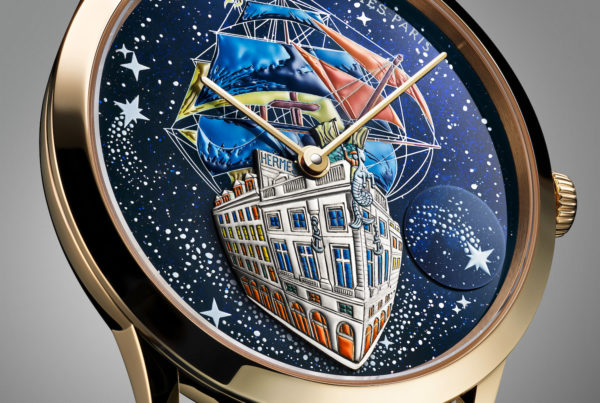Episode 1: The secrets of the Tourbillon Souverain
In a long interview, the master watchmaker explains the origins of four founding timepieces of his brand: the Tourbillon Souverain (1999-2003), the Chronomètre à Résonance (2000-2004), the Sonnerie Souveraine (2006-2019) and the Astronomic Souveraine (2020). In a series of four chapters, he explains the genesis of these four models, their raison d’être, but he also reveals his creative process, the work in progress and his ultimate quest. Isabelle Cerboneschi

Watchmakers who revolutionise their art do not appear in great numbers every century. You can count them on the fingers of one hand. When you are lucky enough to know one of them, to be able to ask him questions in order to try to understand what drives him and what has led him to create timepieces that have set milestones in the history of watchmaking, you don’t miss out.
I met François-Paul Journe in 1999, the year he created his Tourbillon Souverain, which revolutionised this complication patented in 1801 by Abraham-Louis Breguet (1747-1823). The year also when he gave me his first interview. Following him over the years, listening to him recount his latest inventions, his temporary stops or his backward steps that allow him to move forward, it is difficult not to grasp the uniqueness of the character, and consequently, of his creations. This is due to his perfect mastery of his art, his scientific mind, his deep knowledge of watchmaking history, his thoroughness, but also to his intellectual availability, which allows him to find uses for unexpected discoveries.
François-Paul Journe is a hard-working watchmaker but for him, the creative process does not depend solely on the hours he spends with his pencil in his hand and the drawings that result. Things are also born of flashes of inspiration, of intuitions that can happen anywhere, at any time.
Some of his creations have advanced the world of watchmaking, even if he denies it: the Tourbillon Souverain (1999), the Chronomètre à Résonance (2000), the Sonnerie Souveraine (2006) and the Astronomic Souveraine (2020). After all these years, I wanted to understand the raison d’être of these creations, their genesis and above all their spirit, during a long interview. The result of this conversation is a four chapters story, each dedicated to a watch.
This series is aimed at enthusiasts of fine watchmaking but also at history lovers. To explain his approach, François-Paul Journe places his creations in their historical context. An object is not born by chance and a watch is much more than an object…
The first chapter is dedicated to his tourbillon with a remontoir d’égalité, named Tourbillon Souverain and created in 1999. Sold by subscription as Abraham-Louis Breguet did before him, the 20 models quickly found takers. But François-Paul Journe’s watchmaking is evolutionary: just because he has created a model that works does not mean he will keep it as it is: he always tries to make it evolve. In 2003, he therefore created a new generation of Tourbillon Souverain with a deadbeat second (the hand remains stationary until the second has elapsed, editor’s note) which makes a jump, like on a quartz watch. Then in 2019, it launched a new version: the Vertical Tourbillon Souverain, with a regulating organ placed not horizontally but in a vertical position.
But back to the original model… It was in 1999 that he launched his first tourbillon wristwatch with a remontoir d’égalité, a device that “equalizes” the energy sent to the escapement.
Before even beginning the interview, François-Paul Journe warns: “Watchmaking, even the one I make, is a fossil science, because we no longer need it. We’re playing with completely useless concepts from the 18th and 19th centuries, but which make people dream.” And so, with absolute calm, the master watchmaker affirms that what he has been working on passionately since 1983, when he completed his first tourbillon pocket watch with a remontoir d’égalité, is a flamboyant art of the useless…
INTERVIEW
Why did you choose to create a tourbillon with remontoir d’égalité as your first wristwatch?
François-Paul Journe : I always start with a historical base and then develop it further. It’s like cooking: you mix ingredients that will improve the result. There had been tourbillons before, but not with a remontoir d’égalité and even less so on a wristwatch. This timepiece was an evolution of the tourbillon.
In order to obtain a more constant force that reaches the escapement, why didn’t you choose an alternative: the fusee or the stopwork?
Because thess solutions are archaic. The day we made good springs, we stopped using fusee.
Did you create this model to continue the adventure of your first tourbillon pocket watch with a remontoir from 1983?
No, not at all: if I had had to miniaturise that pocket watch, it would have been a Chronograph Souverain with a tourbillon. When I created the Tourbillon Souverain, the fashion for pocket watches had passed. During the 1970s and 1980s, watch collectors were collecting 16th, 17th, 18th and 19th century pocket watches. In 1980, they would not have wanted a Patek Philippe wristwatch with triple complications. At the time, they found it uninteresting. Collectors liked pocket watches because they could hold them in their hands and the time was visible.

How did collectors’ interest in wristwatches evolve?
They started to appear at auctions under the impetus of Osvaldo Patrizzi (co-founder of the auction house Antiquorum, editor’s note) around 1985, because he was looking for an alternative to pocket watches: their price was starting to fall. Shortly afterwards, I made my first wristwatch. The world was changing and I adapted. My technique had also improved: when you start in this business, you gain valuable experience by working on a larger format. My 1983 pocket watch was fully influenced by Abraham-Louis Breguet, as was George Daniels’. The 1991 watch was a tribute wristwatch, with the tourbillon cage according to Dunand, the Breguet hands, the way of placing the small hour dial on the plate in the style of Ferdinand Berthoud’s marine chronometers, a remontoir d’égalité which represents the Grail of watchmaking, because it aims at making the oscillations isochronous. But the real Grail is the constant force, the real one, where each impulse is of the same quantity.
Is the absolute constant force attainable?
No, because it all happens in the escapement and the parts that have to be added to the escapement to achieve it will create friction that will alter the movement. Anthony Randall created a clock with a true constant-force escapement, but he couldn’t have done it on a watch scale.
Several watchmakers – Jobst Bürgi, Thomas Mudge, George Daniels and others – have interpreted the principle of the remontoir d’égalité in their own way. What is your own interpretation?
When I made my first watch, George Daniels had just created a tourbillon with a remontoir d’égalité. A collector in Basel, who was angry with him, came to me and asked me to create a tourbillon with a remontoir d’égalité to annoy George. I went away for the weekend, looked at a picture of George’s watch, I thought his winding-mechanism was too complicated as it didn’t reset itself, but I couldn’t find an alternative. On Tuesday, as I did every Tuesday morning, I went to the Musée des Arts et Métiers to wind the clocks and suddenly a small regulator with an remontoir d’égalité gave me an idea. Immediately I had a flash and I found the solution to create my own. I went back to the workshop, drew my project in five minutes. The collector came, I showed him the drawings and he ordered the watch.
What was that solution?
The one I have adopted on all my watches: a lever that resets itself with a spring. I liked that because it was simple. And it couldn’t fail due to a shock. There are a lot of remontoirs d’égalité that disarm themselves when they reach a weakness in force and the timepiece doesn’t start again. My self-winding system was ideal and I put it everywhere.
How many movements have you designed so far?
I have never calculated all the movements I have designed. Since I started, I’ve launched almost one a year. In my opinion, there are about 21 calibres plus the variations on the 1300 (automatic) and on the resonance.
Why did you give the name “Souverain” to this tourbillon?
It was 1998, I was leafing through a watch magazine at the watchmaker Jean-Pierre Jacquet, in La Chaux-de-Fonds and I was reading the headlines: “Imperial Tourbillon by Franck Muller”, “Royal Tourbillon”, etc. I suddenly said to myself that I was going to call mine Souverain because a sovereign is above everything! (laughs).
















